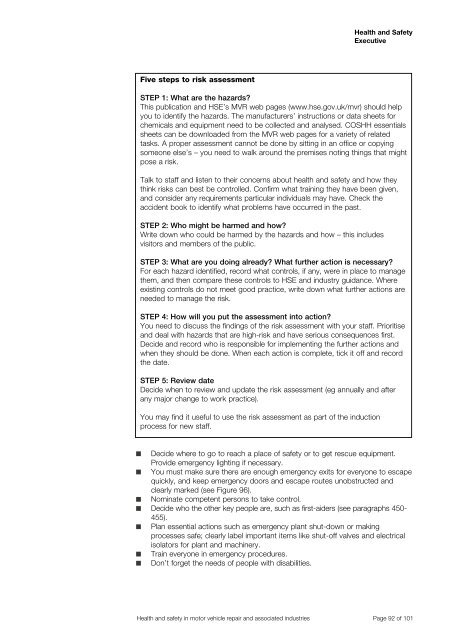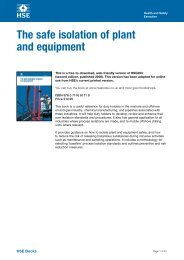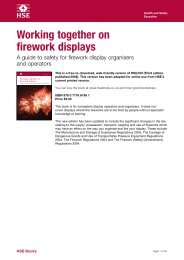Health and safety in motor vehicle repair and associated industries
Health and safety in motor vehicle repair and associated industries
Health and safety in motor vehicle repair and associated industries
You also want an ePaper? Increase the reach of your titles
YUMPU automatically turns print PDFs into web optimized ePapers that Google loves.
n<br />
n<br />
n<br />
n<br />
n<br />
n<br />
n<br />
Five steps to risk assessment<br />
<strong>Health</strong> <strong>and</strong> Safety<br />
Executive<br />
STEP 1: What are the hazards?<br />
This publication <strong>and</strong> HSE’s MVR web pages (www.hse.gov.uk/mvr) should help<br />
you to identify the hazards. The manufacturers’ <strong>in</strong>structions or data sheets for<br />
chemicals <strong>and</strong> equipment need to be collected <strong>and</strong> analysed. COSHH essentials<br />
sheets can be downloaded from the MVR web pages for a variety of related<br />
tasks. A proper assessment cannot be done by sitt<strong>in</strong>g <strong>in</strong> an office or copy<strong>in</strong>g<br />
someone else’s – you need to walk around the premises not<strong>in</strong>g th<strong>in</strong>gs that might<br />
pose a risk.<br />
Talk to staff <strong>and</strong> listen to their concerns about health <strong>and</strong> <strong>safety</strong> <strong>and</strong> how they<br />
th<strong>in</strong>k risks can best be controlled. Confirm what tra<strong>in</strong><strong>in</strong>g they have been given,<br />
<strong>and</strong> consider any requirements particular <strong>in</strong>dividuals may have. Check the<br />
accident book to identify what problems have occurred <strong>in</strong> the past.<br />
STEP 2: Who might be harmed <strong>and</strong> how?<br />
Write down who could be harmed by the hazards <strong>and</strong> how – this <strong>in</strong>cludes<br />
visitors <strong>and</strong> members of the public.<br />
STEP 3: What are you do<strong>in</strong>g already? What further action is necessary?<br />
For each hazard identified, record what controls, if any, were <strong>in</strong> place to manage<br />
them, <strong>and</strong> then compare these controls to HSE <strong>and</strong> <strong>in</strong>dustry guidance. Where<br />
exist<strong>in</strong>g controls do not meet good practice, write down what further actions are<br />
needed to manage the risk.<br />
STEP 4: How will you put the assessment <strong>in</strong>to action?<br />
You need to discuss the f<strong>in</strong>d<strong>in</strong>gs of the risk assessment with your staff. Prioritise<br />
<strong>and</strong> deal with hazards that are high-risk <strong>and</strong> have serious consequences first.<br />
Decide <strong>and</strong> record who is responsible for implement<strong>in</strong>g the further actions <strong>and</strong><br />
when they should be done. When each action is complete, tick it off <strong>and</strong> record<br />
the date.<br />
STEP 5: Review date<br />
Decide when to review <strong>and</strong> update the risk assessment (eg annually <strong>and</strong> after<br />
any major change to work practice).<br />
You may f<strong>in</strong>d it useful to use the risk assessment as part of the <strong>in</strong>duction<br />
process for new staff.<br />
Decide where to go to reach a place of <strong>safety</strong> or to get rescue equipment.<br />
Provide emergency light<strong>in</strong>g if necessary.<br />
You must make sure there are enough emergency exits for everyone to escape<br />
quickly, <strong>and</strong> keep emergency doors <strong>and</strong> escape routes unobstructed <strong>and</strong><br />
clearly marked (see Figure 96).<br />
Nom<strong>in</strong>ate competent persons to take control.<br />
Decide who the other key people are, such as first-aiders (see paragraphs 450-<br />
455).<br />
Plan essential actions such as emergency plant shut-down or mak<strong>in</strong>g<br />
processes safe; clearly label important items like shut-off valves <strong>and</strong> electrical<br />
isolators for plant <strong>and</strong> mach<strong>in</strong>ery.<br />
Tra<strong>in</strong> everyone <strong>in</strong> emergency procedures.<br />
Don’t forget the needs of people with disabilities.<br />
<strong>Health</strong> <strong>and</strong> <strong>safety</strong> <strong>in</strong> <strong>motor</strong> <strong>vehicle</strong> <strong>repair</strong> <strong>and</strong> <strong>associated</strong> <strong>in</strong>dustries Page 92 of 101







